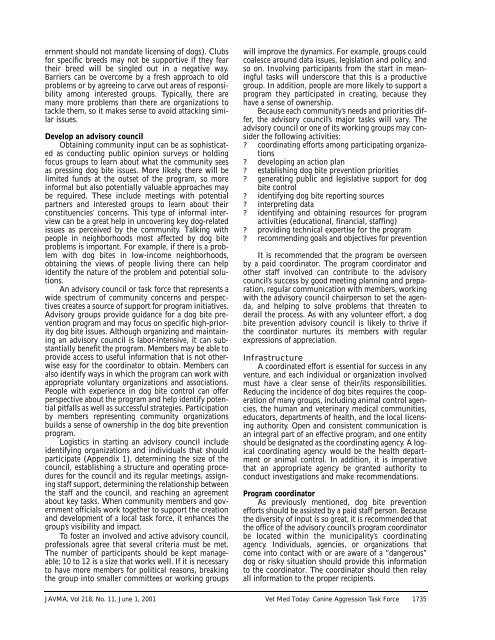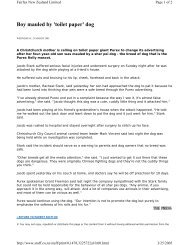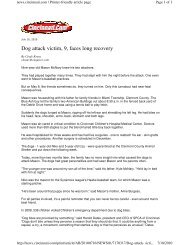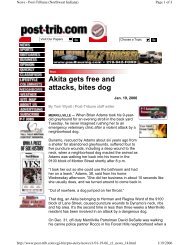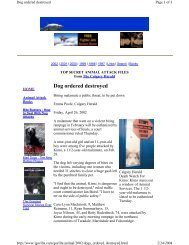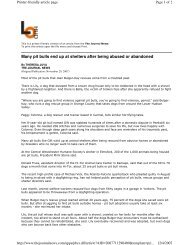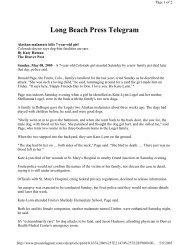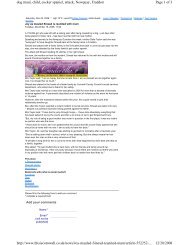A community approach to dog bite prevention - American Veterinary ...
A community approach to dog bite prevention - American Veterinary ...
A community approach to dog bite prevention - American Veterinary ...
You also want an ePaper? Increase the reach of your titles
YUMPU automatically turns print PDFs into web optimized ePapers that Google loves.
ernment should not mandate licensing of <strong>dog</strong>s). Clubs<br />
for specific breeds may not be supportive if they fear<br />
their breed will be singled out in a negative way.<br />
Barriers can be overcome by a fresh <strong>approach</strong> <strong>to</strong> old<br />
problems or by agreeing <strong>to</strong> carve out areas of responsibility<br />
among interested groups. Typically, there are<br />
many more problems than there are organizations <strong>to</strong><br />
tackle them, so it makes sense <strong>to</strong> avoid attacking similar<br />
issues.<br />
Develop an advisory council<br />
Obtaining <strong>community</strong> input can be as sophisticated<br />
as conducting public opinion surveys or holding<br />
focus groups <strong>to</strong> learn about what the <strong>community</strong> sees<br />
as pressing <strong>dog</strong> <strong>bite</strong> issues. More likely, there will be<br />
limited funds at the outset of the program, so more<br />
informal but also potentially valuable <strong>approach</strong>es may<br />
be required. These include meetings with potential<br />
partners and interested groups <strong>to</strong> learn about their<br />
constituencies’ concerns. This type of informal interview<br />
can be a great help in uncovering key <strong>dog</strong>-related<br />
issues as perceived by the <strong>community</strong>. Talking with<br />
people in neighborhoods most affected by <strong>dog</strong> <strong>bite</strong><br />
problems is important. For example, if there is a problem<br />
with <strong>dog</strong> <strong>bite</strong>s in low-income neighborhoods,<br />
obtaining the views of people living there can help<br />
identify the nature of the problem and potential solutions.<br />
An advisory council or task force that represents a<br />
wide spectrum of <strong>community</strong> concerns and perspectives<br />
creates a source of support for program initiatives.<br />
Advisory groups provide guidance for a <strong>dog</strong> <strong>bite</strong> <strong>prevention</strong><br />
program and may focus on specific high-priority<br />
<strong>dog</strong> <strong>bite</strong> issues. Although organizing and maintaining<br />
an advisory council is labor-intensive, it can substantially<br />
benefit the program. Members may be able <strong>to</strong><br />
provide access <strong>to</strong> useful information that is not otherwise<br />
easy for the coordina<strong>to</strong>r <strong>to</strong> obtain. Members can<br />
also identify ways in which the program can work with<br />
appropriate voluntary organizations and associations.<br />
People with experience in <strong>dog</strong> <strong>bite</strong> control can offer<br />
perspective about the program and help identify potential<br />
pitfalls as well as successful strategies. Participation<br />
by members representing <strong>community</strong> organizations<br />
builds a sense of ownership in the <strong>dog</strong> <strong>bite</strong> <strong>prevention</strong><br />
program.<br />
Logistics in starting an advisory council include<br />
identifying organizations and individuals that should<br />
participate (Appendix 1), determining the size of the<br />
council, establishing a structure and operating procedures<br />
for the council and its regular meetings, assigning<br />
staff support, determining the relationship between<br />
the staff and the council, and reaching an agreement<br />
about key tasks. When <strong>community</strong> members and government<br />
officials work <strong>to</strong>gether <strong>to</strong> support the creation<br />
and development of a local task force, it enhances the<br />
group’s visibility and impact.<br />
To foster an involved and active advisory council,<br />
professionals agree that several criteria must be met.<br />
The number of participants should be kept manageable;<br />
10 <strong>to</strong> 12 is a size that works well. If it is necessary<br />
<strong>to</strong> have more members for political reasons, breaking<br />
the group in<strong>to</strong> smaller committees or working groups<br />
will improve the dynamics. For example, groups could<br />
coalesce around data issues, legislation and policy, and<br />
so on. Involving participants from the start in meaningful<br />
tasks will underscore that this is a productive<br />
group. In addition, people are more likely <strong>to</strong> support a<br />
program they participated in creating, because they<br />
have a sense of ownership.<br />
Because each <strong>community</strong>’s needs and priorities differ,<br />
the advisory council’s major tasks will vary. The<br />
advisory council or one of its working groups may consider<br />
the following activities:<br />
? coordinating efforts among participating organizations<br />
? developing an action plan<br />
? establishing <strong>dog</strong> <strong>bite</strong> <strong>prevention</strong> priorities<br />
? generating public and legislative support for <strong>dog</strong><br />
<strong>bite</strong> control<br />
? identifying <strong>dog</strong> <strong>bite</strong> reporting sources<br />
? interpreting data<br />
? identifying and obtaining resources for program<br />
activities (educational, financial, staffing)<br />
? providing technical expertise for the program<br />
? recommending goals and objectives for <strong>prevention</strong><br />
It is recommended that the program be overseen<br />
by a paid coordina<strong>to</strong>r. The program coordina<strong>to</strong>r and<br />
other staff involved can contribute <strong>to</strong> the advisory<br />
council’s success by good meeting planning and preparation,<br />
regular communication with members, working<br />
with the advisory council chairperson <strong>to</strong> set the agenda,<br />
and helping <strong>to</strong> solve problems that threaten <strong>to</strong><br />
derail the process. As with any volunteer effort, a <strong>dog</strong><br />
<strong>bite</strong> <strong>prevention</strong> advisory council is likely <strong>to</strong> thrive if<br />
the coordina<strong>to</strong>r nurtures its members with regular<br />
expressions of appreciation.<br />
Infrastructure<br />
A coordinated effort is essential for success in any<br />
venture, and each individual or organization involved<br />
must have a clear sense of their/its responsibilities.<br />
Reducing the incidence of <strong>dog</strong> <strong>bite</strong>s requires the cooperation<br />
of many groups, including animal control agencies,<br />
the human and veterinary medical communities,<br />
educa<strong>to</strong>rs, departments of health, and the local licensing<br />
authority. Open and consistent communication is<br />
an integral part of an effective program, and one entity<br />
should be designated as the coordinating agency. A logical<br />
coordinating agency would be the health department<br />
or animal control. In addition, it is imperative<br />
that an appropriate agency be granted authority <strong>to</strong><br />
conduct investigations and make recommendations.<br />
Program coordina<strong>to</strong>r<br />
As previously mentioned, <strong>dog</strong> <strong>bite</strong> <strong>prevention</strong><br />
efforts should be assisted by a paid staff person. Because<br />
the diversity of input is so great, it is recommended that<br />
the office of the advisory council’s program coordina<strong>to</strong>r<br />
be located within the municipality’s coordinating<br />
agency. Individuals, agencies, or organizations that<br />
come in<strong>to</strong> contact with or are aware of a “dangerous”<br />
<strong>dog</strong> or risky situation should provide this information<br />
<strong>to</strong> the coordina<strong>to</strong>r. The coordina<strong>to</strong>r should then relay<br />
all information <strong>to</strong> the proper recipients.<br />
JAVMA, Vol 218, No. 11, June 1, 2001 Vet Med Today: Canine Aggression Task Force 1735


